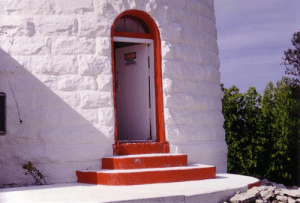Entering the cold, damp and musty tower through the heavy wood door, one is immediately greeted by worn, circular dark gray stairs rising upwards. On each landing a small window with a deep sill breaks the darkness inside the tower.
The ghosts of light keepers can be visualized climbing the 109 steep and narrow steps to the lantern room at dusk every evening carrying cans of sperm whale oil or kerosene to fuel the lamp. Throughout the often long night, he kept a constant vigil adjusting the height of the flame, and winding the rotating mechanism. Ascending the stairs at dawn he would extinguish the lamp, trim the wick, clean and polish the lenses.
the tower
…the panoramic view from the bright red lantern room is breath taking. The contrasting green of the forest and the light and dark blues of the water is the same spectacular view witnessed at Cove Island by inaugural lightkeeper, George Collins when he lit the whale oil lantern for the first time in late October 1858.
Under the eves, drain spouts disguised as bronze gargoyles are still in place. A symbol of a forgotten and less complicated age, they keeptheir silent vigil over the water for sailing ships that will never return.
The original Fresnel lenses put in place by French workers in 1858, are still in use today. The original weight driven mechanism that rotated the lenses remains idle, waiting for the lightkeeper to wind the cable in preparation for another night’s work.






